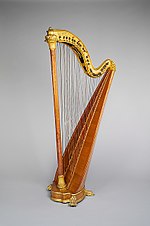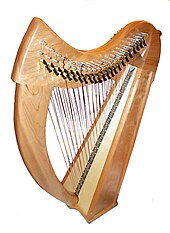Double harp
| Double harp | |
|---|---|
| engl .: double harp , ital .: arpa doppia | |
| Chromatic double harp (Pleyel, Wolff, Lyon & Cie., Early 20th century). | |
| classification | Plucked instrument |
A double harp is a harp with two rows of strings that either run parallel to each other or cross each other without touching. Triple harps have three rows of strings.
A distinction is made between diatonic- tuned double harps (on which only the notes of the C major scale can be played without retuning the individual strings ) and chromatically tuned double harps. The Hornbostel-Sachs system includes “chromatic frame harps with two crossed strings” under item 322.212.2; Diatonic double harps and chromatic double and triple harps with parallel strings are not recorded separately.
The double harp is not to be confused with the double pedal harp , the modern concert harp. The term “double harp” has occasionally been used in history to refer to particularly large harps.
Diatonic tuned double harps
Diatonic tuned double harps have two parallel rows of strings that are either tuned the same or (more often) in octaves . On smaller harps, the volume can be increased or the range can be enlarged.
Chromatically tuned double and triple harps
Chromatically tuned double harps enable chromatic playing by having one row of strings tuned diatonic and the other pentatonic completing the missing notes of the chromatic , so that each of the twelve semitones of the chromatic scale has its own string. In this way all keys can be played.
history
Only diatonic harps existed until the Renaissance ; So only one key could be played on the instrument and it had to be retuned by hand in order to change to another key. In the 16th century, instrument makers sought to enable the increasingly chromatic music of the late Renaissance to be played on the harp as well. This is how the first double harps came about.
In parallel, single-row harps continued to be used, and there were also single-row harps, some of which were chromatically tuned.
At the end of the 18th century the (simple) pedal harp replaced the double and triple harps after both types had coexisted for a while. Double harps are still used in folk music today .
Designs
Italy: Arpa doppia and Arpa tripla
The Italian double harp, the arpa doppia , had two parallel strings: one level was diatonic, the other was tuned in the chromatic intermediate levels. The triple harp, the Arpa tripla, had a diatonic row of strings on the outside and the pentatonic notes that complement the chromatic row in the middle.
The Italian double harp was used in the orchestra as a thoroughbass instrument , for example in Claudio Monteverdi's operas .
Spain: Arpa de dos órdenes
The Spanish double harp, the arpa de dos órdenes , was used in baroque music . Their strings were arranged crossed and were plucked at the crossing point: to reach the semitones , the musician reached through the diatonic strings.
France: Harpe chromatique
In France, the chromatic double harp (arpe chromatique) with crossed strings experienced a brief renaissance with the Pleyel or Lyons harp at the end of the 19th century.
British Isles: Celtic double harp and Welsh triple harp
The Welsh triple harp is represented in British music . In Irish folk music today, Celtic harps are also used as double harps .
Individual evidence
- ^ A b c Cheryl Ann Fulton: Harp - Multi-rank harps in Europe outside Spain. In: Grove Music Online (English; subscription required).
- ↑ a b c Harp - History 2 - Renaissance to Modern. In: Vienna Symphonic Library. Retrieved February 17, 2018 .
- ↑ Joan Rimmer: Harp - Other single-rank harps. In: Grove Music Online (English; subscription required).
- ↑ Erich Valentin: Handbuch der Musikinstrumentenkunde . 6th edition. Gustav Bosse, Regensburg 1974, p. 188 .



